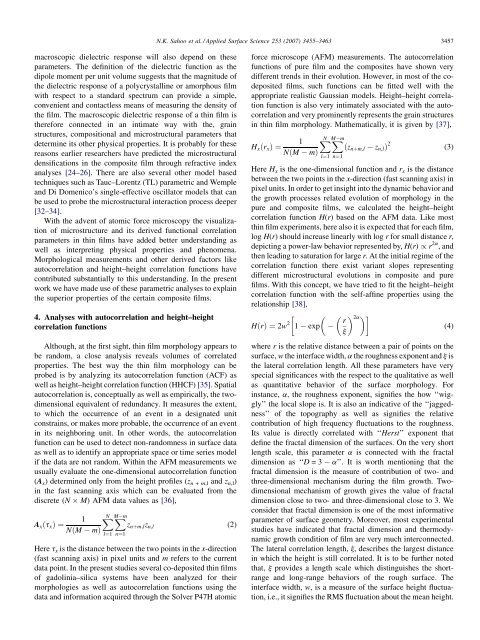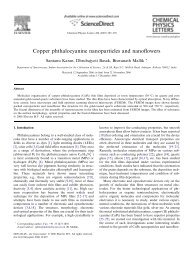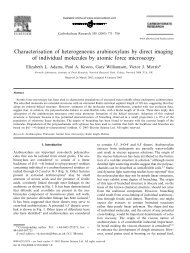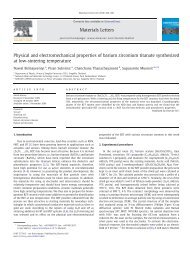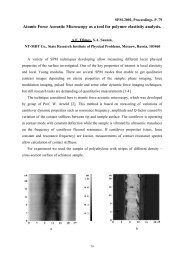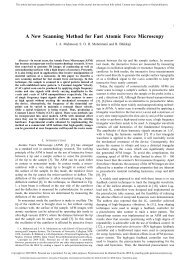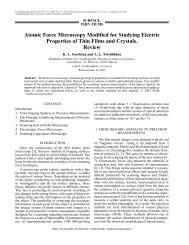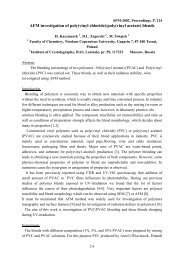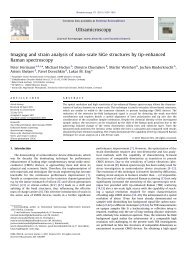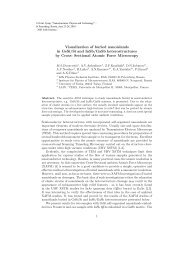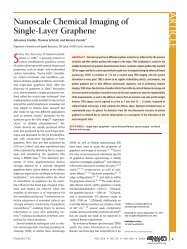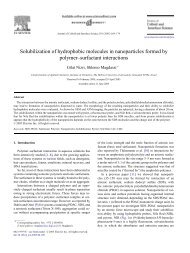Morphological, microstructural and optical properties supremacy of ...
Morphological, microstructural and optical properties supremacy of ...
Morphological, microstructural and optical properties supremacy of ...
Create successful ePaper yourself
Turn your PDF publications into a flip-book with our unique Google optimized e-Paper software.
N.K. Sahoo et al. / Applied Surface Science 253 (2007) 3455–3463 3457macroscopic dielectric response will also depend on theseparameters. The definition <strong>of</strong> the dielectric function as thedipole moment per unit volume suggests that the magnitude <strong>of</strong>the dielectric response <strong>of</strong> a polycrystalline or amorphous filmwith respect to a st<strong>and</strong>ard spectrum can provide a simple,convenient <strong>and</strong> contactless means <strong>of</strong> measuring the density <strong>of</strong>the film. The macroscopic dielectric response <strong>of</strong> a thin film istherefore connected in an intimate way with the, grainstructures, compositional <strong>and</strong> <strong>microstructural</strong> parameters thatdetermine its other physical <strong>properties</strong>. It is probably for thesereasons earlier researchers have predicted the <strong>microstructural</strong>densifications in the composite film through refractive indexanalyses [24–26]. There are also several other model basedtechniques such as Tauc–Lorentz (TL) parametric <strong>and</strong> Wemple<strong>and</strong> Di Domenico’s single-effective oscillator models that canbe used to probe the <strong>microstructural</strong> interaction process deeper[32–34].With the advent <strong>of</strong> atomic force microscopy the visualization<strong>of</strong> microstructure <strong>and</strong> its derived functional correlationparameters in thin films have added better underst<strong>and</strong>ing aswell as interpreting physical <strong>properties</strong> <strong>and</strong> phenomena.<strong>Morphological</strong> measurements <strong>and</strong> other derived factors likeautocorrelation <strong>and</strong> height–height correlation functions havecontributed substantially to this underst<strong>and</strong>ing. In the presentwork we have made use <strong>of</strong> these parametric analyses to explainthe superior <strong>properties</strong> <strong>of</strong> the certain composite films.4. Analyses with autocorrelation <strong>and</strong> height–heightcorrelation functionsAlthough, at the first sight, thin film morphology appears tobe r<strong>and</strong>om, a close analysis reveals volumes <strong>of</strong> correlated<strong>properties</strong>. The best way the thin film morphology can beprobed is by analyzing its autocorrelation function (ACF) aswell as height–height correlation function (HHCF) [35]. Spatialautocorrelation is, conceptually as well as empirically, the twodimensionalequivalent <strong>of</strong> redundancy. It measures the extent,to which the occurrence <strong>of</strong> an event in a designated unitconstrains, or makes more probable, the occurrence <strong>of</strong> an eventin its neighboring unit. In other words, the autocorrelationfunction can be used to detect non-r<strong>and</strong>omness in surface dataas well as to identify an appropriate space or time series modelif the data are not r<strong>and</strong>om. Within the AFM measurements weusually evaluate the one-dimensional autocorrelation function(A x ) determined only from the height pr<strong>of</strong>iles (z n + m,l <strong>and</strong> z n,l )in the fast scanning axis which can be evaluated from thediscrete (N M) AFM data values as [36],A x ðt x Þ¼1NðMmÞX NXMml¼1 n¼1z nþm;l z n;l (2)Here t x is the distance between the two points in the x-direction(fast scanning axis) in pixel units <strong>and</strong> m refers to the currentdata point. In the present studies several co-deposited thin films<strong>of</strong> gadolinia–silica systems have been analyzed for theirmorphologies as well as autocorrelation functions using thedata <strong>and</strong> information acquired through the Solver P47H atomicforce microscope (AFM) measurements. The autocorrelationfunctions <strong>of</strong> pure film <strong>and</strong> the composites have shown verydifferent trends in their evolution. However, in most <strong>of</strong> the codepositedfilms, such functions can be fitted well with theappropriate realistic Gaussian models. Height–height correlationfunction is also very intimately associated with the autocorrelation<strong>and</strong> very prominently represents the grain structuresin thin film morphology. Mathematically, it is given by [37],H x ðr x Þ¼1NðMmÞX NXMml¼1 n¼1ðz nþm;l z n;l Þ 2 (3)Here H x is the one-dimensional function <strong>and</strong> r x is the distancebetween the two points in the x-direction (fast scanning axis) inpixel units. In order to get insight into the dynamic behavior <strong>and</strong>the growth processes related evolution <strong>of</strong> morphology in thepure <strong>and</strong> composite films, we calculated the height–heightcorrelation function H(r) based on the AFM data. Like mostthin film experiments, here also it is expected that for each film,log H(r) should increase linearly with log r for small distance r,depicting a power-law behavior represented by, H(r) / r 2a , <strong>and</strong>then leading to saturation for large r. At the initial regime <strong>of</strong> thecorrelation function there exist variant slopes representingdifferent <strong>microstructural</strong> evolutions in composite <strong>and</strong> purefilms. With this concept, we have tried to fit the height–heightcorrelation function with the self-affine <strong>properties</strong> using therelationship [38], 2a rHðrÞ ¼2w1 2 exp(4)jwhere r is the relative distance between a pair <strong>of</strong> points on thesurface, w the interface width, a the roughness exponent <strong>and</strong> j isthe lateral correlation length. All these parameters have veryspecial significances with the respect to the qualitative as wellas quantitative behavior <strong>of</strong> the surface morphology. Forinstance, a, the roughness exponent, signifies the how ‘‘wiggly’’the local slope is. It is also an indicative <strong>of</strong> the ‘‘jaggedness’’<strong>of</strong> the topography as well as signifies the relativecontribution <strong>of</strong> high frequency fluctuations to the roughness.Its value is directly correlated with ‘‘Herst’’ exponent thatdefine the fractal dimension <strong>of</strong> the surfaces. On the very shortlength scale, this parameter a is connected with the fractaldimension as ‘‘D =3 a’’. It is worth mentioning that thefractal dimension is the measure <strong>of</strong> contribution <strong>of</strong> two- <strong>and</strong>three-dimensional mechanism during the film growth. Twodimensionalmechanism <strong>of</strong> growth gives the value <strong>of</strong> fractaldimension close to two- <strong>and</strong> three-dimensional close to 3. Weconsider that fractal dimension is one <strong>of</strong> the most informativeparameter <strong>of</strong> surface geometry. Moreover, most experimentalstudies have indicated that fractal dimension <strong>and</strong> thermodynamicgrowth condition <strong>of</strong> film are very much interconnected.The lateral correlation length, j, describes the largest distancein which the height is still correlated. It is to be further notedthat, j provides a length scale which distinguishes the shortrange<strong>and</strong> long-range behaviors <strong>of</strong> the rough surface. Theinterface width, w, is a measure <strong>of</strong> the surface height fluctuation,i.e., it signifies the RMS fluctuation about the mean height.


